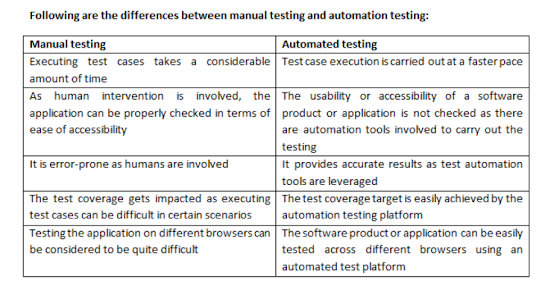Manual Testing vs Automated Testing: Key Differences
Manual testing and automation testing play a crucial role in software development and testing activities. There are certain software development scenarios where manual testing plays a crucial role and certain scenarios where automation testing plays a crucial role.
Depending upon the project scope and requirements, the team can decide as to which of the one of two testing types can be leveraged or even both can be used tactically. In this article, you will get to know the differences between manual testing and automated testing.
What is manual testing?
It is a testing method wherein test cases are prepared by manual testers for the code to test the software and then the final report of the software is presented. It is a time-consuming process as it is done manually. Bugs are uncovered using this testing method. All the essential features of the software product or application are thoroughly checked by the software product or application.
Characteristics of manual testing:
1. The involvement of humans: Human testers undertake manual testing and rely on their specific skills and knowledge. Different features of the software product or application can be explored by them using their discretion. The results of the testing will vary depending on the motivation and expertise of each tester.
2. The significance of flexibility: Whenever there is a change in the software product, the approach can be dynamically changed by the manual testers. Random testing can be performed and bugs can be identified that have not been already outlined in test cases.
3. Responsiveness: Crucial feedback can be provided by exploratory testing right in the initial stages of the software development life cycle process. When the bugs are identified in the initial stages by the testers then development team can easily fix them.
What is automated testing?
It is a testing method where automation tools are used to test the product or application without any human intervention. Scripts are written by tools and test cases are executed. It is known for the speed of execution, accuracy and effectiveness. Mundane and time-consuming tasks are carried out by automation testing.
Characteristics of automated testing:
1. The objective factor: The test scripts are not being deviated from the automation testing platform. If there are well-written test cases then there will be no bias interfering with results or issues with human errors.
2. The value of repeatability: Automated test scripts can be reused as and when required thereby saving valuable time. There will be scenarios with repetitive tasks, wherein this characteristic will prove to be of value.
3. Scalable: It is easy to scale automated tests. Testers can iterate or expand on them as a system becomes more complex or there is a change in features.
Conclusion: The above differences between manual testing and automation testing might have given you some idea about the relevance of both of these important methodologies. If you are looking forward to implementing a result-oriented software testing plan for your specific software development project, then do get connected with a leading automation testing services company that will provide you a highly resourceful, strategic plan of action that is in line with your specific project needs.
About the author: I am a technical content writer focused on writing technology specific articles. I strive to provide well-researched information on the leading market savvy technologies.



Comments
Post a Comment